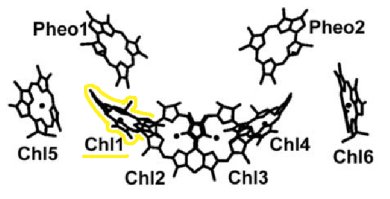Reaction centres of photosystem II
Overview |
|
Photosystem II (PSII) is a pigment-protein complex located in thylakoid membrane of cyanobacteria, algae and higher plants. It performs series of light driven reactions, which result in a separation of charge and subsequently in a reduction of an electron-transport chain and water oxidation. Primary site of the light energy conversion is located in so-called reaction centre (RC). In its simplest form RC consists of a heterodimer of D1 and D2 proteins with two subunits of cytochrome b559 α and β and psbI protein. Isolated RC binds 6 molecules of chlorophyll a, 2 pheophytin a, 2 molecules of β-carotene and an atom of non-heme iron. |
 Localisation of chlorophyll cation
Localisation of chlorophyll cationJoint project with the group of František Vácha from ASCR, České Budějovice Absorption and circular dichroism spectra of Photosystem II reaction centres were studied experimentally and compared with spectra calculated on the basis of point-dipole approximation. Chlorophyll cation was accumulated during a light treatment of Photosystem II reaction centre in presence of artificial electron acceptor silicomolybdate. Light induced difference spectra and their calculated counterparts revealed the location of accumulated cation at the accessory chlorophyll of the D1 protein subunit. The results suggest that the accessory chlorophyll of the D1 protein subunit is the primary donor of PS II. - details can be found in Vacha et al. (2005) Photosynth Res 84 |
